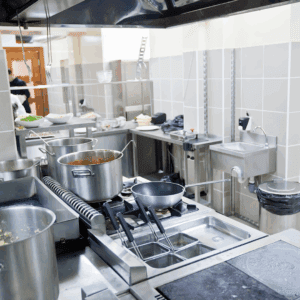When planning a stainless steel countertop installation, you’ll navigate a detailed stainless steel countertop fabrication process that impacts both function and aesthetics. You’ll need to select appropriate steel grades, determine precise measurements, and choose from various finish options that align with your interior design. Integrating sinks, appliances, and sound-dampening features requires technical expertise beyond countertop materials. Understanding these fabrication specifics now will help you avoid costly mistakes and guarantee your commercial or residential project achieves professional-grade results.
Selecting the Right Grade of Stainless Steel

When commencing a countertop fabrication project, you must determine the appropriate stainless steel grade to match your requirements. The most widely employed option is 304 stainless steel, which offers excellent corrosion resistance with an 18% chromium and 8% nickel composition—ideal for standard kitchen environments.
For spaces exposed to caustic acids or saltwater, consider 316 stainless steel with a 3% molybdenum addition for superior durability.
Gauge differences considerably impact performance: Thicker 14- 16 gauge steel suits commercial applications requiring robust surfaces, while 18-20 gauge works well in residential settings.
Gauge selection also affects longevity; properly maintained thick-gauge countertops can exceed 20 years of service.
Evaluate your space requirements carefully. Your project’s commercial versus residential usage, chemical exposure, and anticipated wear patterns will dictate the ideal stainless steel types.
Custom Sizing and Design Considerations
Custom sizing is the foundation of any successful stainless steel countertop installation. It requires precise measurements to guarantee perfect alignment with your cabinetry or island substructures.
When planning your design, you’ll select from edge profiles, such as beveled or bullnose, that complement your custom kitchen workflows while maintaining aesthetic cohesion.
For ideal results, you’ll need professional fabricators who expertly cut and fit steel sheets without visible seams.
Consider extending your design with a matching backsplash for visual continuity and enhanced functionality.
Budget considerations include potential upgrades to thicker gauge steel for high-traffic areas, while material sourcing strategies can affect quality and cost.
Research design inspiration sources to determine finishes that harmonize with existing appliances.
Remember that thoughtful customization choices will impact the long-term countertop maintenance tips you must follow.
Edge Profiles and Finishing Options
Edge profiles and finishing selections determine both the aesthetics and functionality of your stainless steel countertop installation.
Based on your aesthetic preferences and practical needs, you’ll choose from standard flat, beveled, or bullnose edge styles. The finish you select—brushed, mirror, or matte—directly impacts both appearance and finish durability. Most clients prefer brushed finishes for their directional grain, which conceals daily wear.
- Brushed finishes offer the ideal balance between sophisticated appearance and practical maintenance, as their textured surface masks fingerprints and minor scratches.
- Non-welded butt seams provide advanced installation techniques for seamless shifts, creating a monolithic surface appearance.
- Extending stainless steel to create matching backsplashes enhances your customization options while providing a cohesive design that’s both functional and visually striking.
Integration of Sinks and Appliances

Seamless integration of sinks and appliances represents a critical phase in stainless steel countertop fabrication, requiring careful planning and expert execution.
You’ll need precise measurements to guarantee a perfect fit of sink types—under-mounted or top-mounted—with under-mounted options offering a sleek, continuous surface that’s easier to maintain.
When addressing appliance compatibility, professional fabricators create custom cutouts for cooktops and dishwashers during manufacturing.
Installation challenges often arise with improper measurements, so working with experienced professionals is vital to maintain structural integrity.
Confirm proper sealing around integrated features to prevent moisture damage for maintenance tips.
Current design trends favor minimalist, seamless connections between countertops and fixtures.
This integration enhances functionality and creates a cohesive, sophisticated aesthetic that complements modern kitchen environments.
Sound Deadening Techniques in Fabrication
While stainless steel delivers exceptional durability and hygiene, its hard surface naturally amplifies noise from impacts with cookware, utensils, and other kitchen items. Quality fabricators address this concern by applying specialized soundproofing materials to the underside of your countertop, significantly improving kitchen acoustics.
- Vibration-dampening compounds, typically rubber or foam-based, are strategically applied to reduce resonance and minimize the metallic “ping” often associated with stainless surfaces.
- Professional installation includes noise reduction layers that don’t compromise the countertop’s structural integrity while enhancing daily usability.
- These acoustic treatments contribute to countertop longevity by reducing stress from vibrations and protecting the surface and underlying substrate.
You’ll notice the difference immediately—conversations remain uninterrupted, and kitchen activities proceed without the distracting clatter typical of untreated metal surfaces.
Backsplash Options and Installation
Three primary backsplash configurations enhance stainless steel countertop installations, each offering distinct advantages for your space. The integrated backsplash creates a seamless appearance with marine-style edges that minimize installation challenges and provide superior moisture protection.
Alternatively, flat-edge designs offer a contemporary aesthetic while maintaining functional splash guards.
During fabrication, you’ll need to evaluate backsplash materials comparison—while consistent stainless steel creates cohesion, mixed materials can introduce design trend analysis opportunities. Your fabricator will incorporate sound-deadening materials behind the backsplash to reduce kitchen noise.
Installation requires precise wall attachment techniques, ensuring watertight seals that protect underlying cabinetry.
For maintenance tips, simply wipe with appropriate cleaners to preserve the finish. Color coordination strategies become relevant when integrating stainless steel with existing kitchen elements—consider complementary tones in adjacent materials for a harmonious result.
On-Site Measurement and Template Creation
Accurate on-site measurement represents the foundation of exceptional stainless steel countertop fabrication. Professionals who visit your space employ specialized measurement techniques for wall irregularities, cabinet variations, and existing fixtures. This careful process guarantees template accuracy and addresses installation challenges before they arise.
- Advanced digital tools capture dimensions within millimeters, allowing fabricators to create perfectly fitted countertops with appropriate overhangs and edge profiles.
- On-site considerations include identifying structural supports, examining uneven surfaces, and planning for integrated features like sinks and appliances.
- Each measurement directly translates to fabrication precision, determining cut lines, seam placements, and finish details that affect functionality and aesthetics.
Your template becomes the blueprint that directs every subsequent fabrication step, transforming raw stainless steel into a custom solution precisely matched to your environment.
Final Installation Process and Timeline

Once your custom stainless steel countertop arrives at your location, the final installation phase begins with positioning the fabricated pieces over the prepared wood substructure.
Professional services are crucial for managing installation challenges like non-welded butt seams and achieving seamless finishes that enhance your space’s aesthetics.
Project timelines typically range from several hours to two days, depending on your countertop’s complexity and size.
During installation, you’ll have final customization options, including selecting an edge profile—beveled or bullnose—to balance visual appeal with functionality.
You can extend the stainless steel up the wall as an integrated backsplash for a cohesive look.
For best results, trust certified installers specializing in metal fabrication. They will ensure your investment maintains its precision and durability for years.
Partnering with Experts for Long-Lasting Results
Stainless steel countertop fabrication is more than just a design choice—it’s a strategic investment in durability, hygiene, and timeless aesthetics. Whether outfitting a high-traffic commercial kitchen or upgrading your home culinary space, understanding the steps—from grade selection and acoustic treatments to on-site templating and final installation—ensures your project achieves the professional finish you aim for.
At All Southern Fabricators, we specialize in precision-crafted stainless steel countertops that seamlessly integrate with your layout, design vision, and performance needs. Our experienced team takes pride in delivering expertly welded seams, custom sink and appliance integration, and sound-dampening enhancements that elevate residential and commercial environments.
Your project deserves more than a one-size-fits-all solution. Trust a fabrication partner who combines craftsmanship with cutting-edge equipment to bring your stainless steel vision to life, on time and with lasting quality.
Ready to get started? Contact All Southern Fabricators today for a personalized quote and expert consultation.

